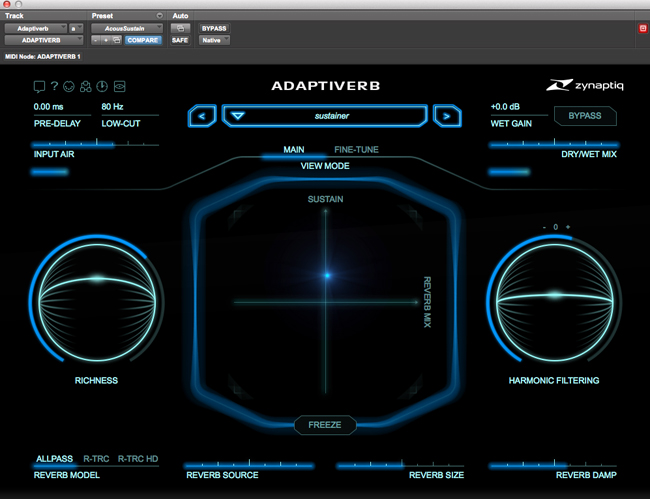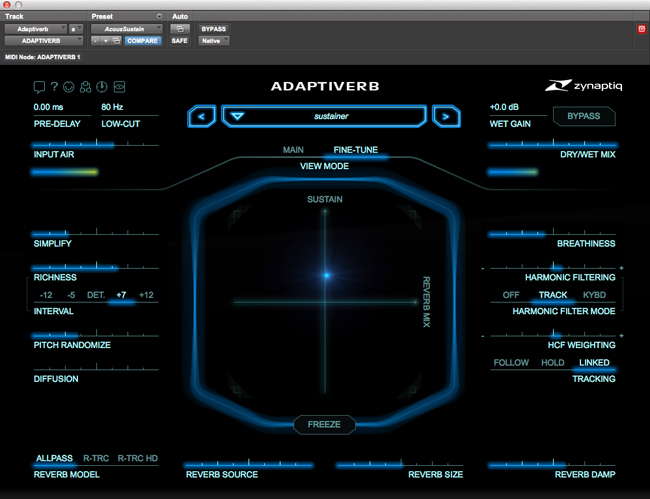|
|
Zynaptiq Adaptiverb ver 1.1
With Comments By David Gamson
|
|
|
 |
| Zynaptiq Adaptiverb Main Page Using Trackball Sliders |
 |
| Zynaptiq Adaptiverb Fine Tune Page |
The Bionic Sustain Re-synthesizer output can be used by itself or as the source input to a reverb section with two, separate digital reverb engines. Each of the two reverbs will work either as traditional AllPass dual mono mode digital reverbs or in Ray Trace or Ray Trace HD modes that I found to have more depth of field and to sound wider.
Zynaptiq uses advanced "ray-tracing modeling" techniques to approximate the 16,000 different paths an audio signal would take to get to the listener from two virtual speakers in a room--but without computing all the reflections. Called a "reflectionless" reverb, this reverb's decay and frequency responses are linear--which does not happen in nature.
A wet/dry mix of the BSR and reverb sections is processed through the Harmonic Contour Filter that removes certain pitched components of the reverb tail that could (potentially) clash with the input signal.
And this is the beauty and uniqueness of this reverb plug-in: you can apply long and beautiful reverberation for additional perceived depth, harmonic richness, and also allow smooth tails without obscuring the musicality of the source. Adaptiverb continuously follows the input audio and conformed its reverb tail to the tonality of the input according to user-defined parameter settings, a set of notes selectable on the GUI or via MIDI keyboard input.
|
Mixing with Adaptiverb
I found using Adaptiverb in my song mixing excellent for any traditional reverberation effects. It has the familiar reverb controls such as: a Wet/Dry control, up to 1,000.00ms of pre-delay plus a high-pass filter up to 1kHz. Whereas before with extra long reverbs, I would have to automate sends and return levels very carefully to avoid messy clashes at the bar line of every chord change--now it's a whole new game!
I tried Adaptiverb on a double-tracked acoustic guitar part that played arpeggios throughout the entire song. Normally for a basic tracking part, I would just use a short plate or small room for adding ambience to this dry recording. But with Adaptiverb I was able to change the entire feel of the song with a sustaining reverb that tracked every chord change exactly.
I arrived at about a 50/50 (wet/dry) blend of the original guitar signal and Adaptiverb and it sounded very much like a wide instrument pad. I increased the plug-in's Input Air control to add sparkle to the guitar's sound (as input source) so that the high frequencies sustained longer. I also automated the Interval setting to +12 (octave up) for an added lift only in the choruses.
I've found my new "go-to" long reverb engine! Adaptiverb sounds great for reverb vocal effects and creating pad sounds from ordinary sounding tracking instruments. I'm just getting going using it and find new applications with every Pro Tools 12 HDX session I open here.
Adaptiverb 1.1 is available for both Mac and PCs and is AU, AAX, VST 2 and 3. It runs Native (host-based) and uses either iLok 2 or PACE hard-disk activation without the iLok dongle. It sells for $249 and there's a promo intro price of $149 in effect until September 30th, 2016. For more about it and to download a trial version, check: www.zynaptiq.com/adaptiverb/.
 |
| Zynaptiq Adaptiverb Signal Flow Chart |
|
|
|